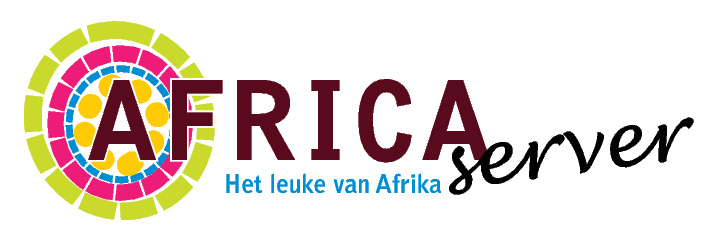Zondag 21 April 2013
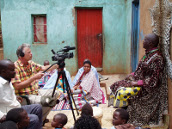
Museumcolleges Blik op Afrika: Wouter van Beek – Zingen in de nacht
Zondag 21 April 2013 14:00 - 15:00
Weinig volken in West-Afrika zijn zo bekend als de Dogon. Hun dorpen zijn gebouwd op en aan de voet van een spectaculaire rotswand. In het Buitenmuseum is een woonerf van de Dogon uit Mali te zien. De Dogon wonen al sinds de 14e eeuw in dit gebied en hebben een kleurrijke cultuur ontwikkeld die al vroeg internationaal de aandacht trok. Dit geldt met name voor hun gemaskerde dansen en ceremonies. In dit college van antropoloog Wouter van Beek staat één lied van de Dogon centraal, namelijk een onderdeel van de eerste begrafenis.

Africa - voorstelling van Peter Verhelst en NTGent
Woensdag 17 April 2013 20:00
t/m Donderdag 25 April 2013
Schrijver en theatermaker Peter Verhelst maakt een monoloog met elk van de acteurs van het sterrenensemble van NTGent. Na Nero met Wim Opbrouck is het de beurt aan Oscar Van Rompay, die naast zijn theaterwerk meehelpt een bedrijf draaiende te houden in Kenia. Ieder jaar reist hij voor enkele maanden naar het land. In 2012 gaat Verhelst met hem mee. Africa wordt een confrontatie tussen het beeldende, mythische theater van Verhelst en de dagelijkse werkelijkheid en idealen van Van Rompay. Hoe kun je iets zinnigs vertellen over je eigen verlangen?

The Mandingo Ambassadors - Music from Guinea
Woensdag 06 Maart 2013 22:00
t/m Woensdag 24 April 2013
This legendary band was formed in the late 1960's by guitarist Mamady "Djelike" Kouyate and singer Emile Soumah. They made some of the most beloved music of their generation. Now based in New York, Mamady Kouyate has decided to revive The Ambassadors. Every Wednesday night.

Tentoonstelling: Onverwachte ontmoetingen
Het Tropenmuseum brengt een ode aan zijn eigen verzamelingen met de tentoonstelling Onverwachte ontmoetingen. Verborgen verhalen uit eigen collectie.
Een Afrikaans krachtbeeld ontmoet een Apple computer en een kunstwerk met portretten van Marlene Dumas een Duitse staalkaart met veertig verschillende oogkleuren.
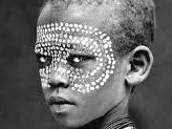
Mario Marino - Faces of Africa
In 2011 reisde fotograaf Mario Marino (Oostenrijk, 1967) naar de Omo vallei in Zuid-Ethiopië, nabij de grens tussen Kenya en Sudan. Zijn ontmoetingen op straat en op de markt resulteerde in een indrukwekkende serie portretten van mensen die behoren tot zeven kleine bevolkingsgroepen: Surma, Karo, Hamar, Borena-Oromo, Tsimaw, Mursi en Erbore. Zelfbewust en trots op hun culturele eigenheid poseerden tientallen mensen voor hem. Uit de lichaamsbeschilderingen, littekentatoeages en sieraden blijkt dat men traditionele opvattingen over schoonheid en identiteit nog steeds belangrijk vindt.

Josiah Onemu - Beelden van een bruggenbouwer
Beeldhouwer en kunstenaar Josiah Onodome Onemu (1945) is afkomstig uit Nigeria. Hij woont en werkt al tientallen jaren in Nederland. Deze expositie toont een overzicht van zijn brede oeuvre, waarvan een deel in beheer is van het Afrika Museum en een deel bestaat uit de privé-collectie van de kunstenaar. Vruchtbaarheid, het samenspel van tegendelen, lijden en wanhoop, hoop en beloftes, verandering en afscheid – de grote thema’s van het leven worden in het werk van Josiah Onemu nu eens sober, tot de essentie gereduceerd, dan weer verhalend in beeld gebracht. Hoe verschillend de uitwerking ook kan zijn, het onderwerp heeft altijd betrekking op mens en maatschappij.

Female Power
Female Power is een tentoonstelling vol vrouwelijke kracht en macht. Van keramische borstvormen en een installatie met gevlochten harnassen tot foto’s van legendarische Japanse vissersvrouwen: steeds meer hedendaagse kunstenaressen creëren nieuwe vrouwbeelden. Hun werk wordt gecombineerd met dat van kunstenaressen die in de jaren ’70 en ’80 van de vorige eeuw met hun positieve vrouwbeelden hebben bijgedragen aan de ‘empowerment’ van vrouwen. Met uit Afrika Nandipha Mntambo (1982 SZ), Tsholofelo Monare (1986 ZA)
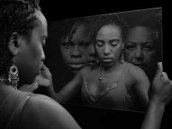
Theater: Rebelse Vrouwen
Door Krater theater i.s.m. NiNsee. De Nigeriaanse Onise wordt onverwacht geconfronteerd met drie vrouwen op haar bed; drie nieuwsgierige vrouwen die onder de indruk zijn van Onises mooie spullen en haar het hemd van het lijf vragen. De vrouwen blijken geesten uit het verleden die op komen draven als er ergens een sisa (zuster) in de problemen zit. Vroeger werkten ze als slavin op de plantages. In korte scènes die inventief switchen tussen heden en verleden, spelen en vertellen zij hun persoonlijke verhalen. In Dordrecht, Almere, Enschede, Rotterdam, Amsterdam, Arnhem, Den Haag, Tilburg
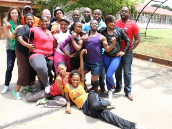
Muziek en Theater: Ikusasa Tour
Deze show is een kleurrijke mix van het spetterende muziek- en dansleven dat Zuid-Afrika rijk is; van traditionele Gospel tot African house, gebracht door een topcast van vijftien zangers dansers, acteurs en musici.

El Anatsui - When I Last Wrote to You about Africa
Brings together the full range of the artist’s work, from wood trays referring to traditional symbols of the Akan people of Ghana; to early ceramics from the artist’s Broken Pots series, driftwood assemblages that refer to the trans-Atlantic slave trade, and wooden sculptures carved with a chainsaw; to the luminous metal wall-hangings of recent years.
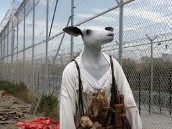
Surveys - Jane Alexander (South Africa)
While Jane Alexander’s figures are, in many ways, emblems of monstrosity, they are oddly beautiful. Her creatures expose the human animal for all it is and all it could become. Though clearly concerned with social issues, Alexander’s sculptural installations and photographs do not judge, nor do they convey a particular political or moral standpoint.
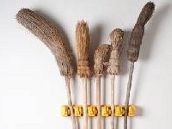
Venus at Home - Usha Seejarim (exhibition)
It's not every day that a housewife looks around her kitchen and sees her utensils as objects of art. But Usha Seejarim is no ordinary housewife. The artist from Bethal, a small town in Mpumalanga, says that "as a home-maker/housewife/mother of two, and an artist", she is fascinated by her everyday chores. When she is in the kitchen, her spoons, forks, knives and plates become art objects. In her latest exhibition, Seejarim takes a closer look at the places and the objects in her immediate surrounds, and the roles she assumes when she is around these objects.
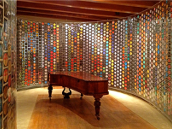
Labels - Siemon Allen (installation)
Siemon Allen’s Labels is a large architectural installation displayed in the museum’s Music Room. This visual memorial to South Africa’s rich musical past features 5000 photographs of record labels inserted into a suspended clear plastic curtain. The site-responsive installation has been configured to converse with part of the museum’s collection of historical artifacts and meanders through the space amongst the musical instruments and clocks, to form a number of intimate accessible enclosures. The exhibition is a historical record, a chronological discography of select labels from Allen's archive.
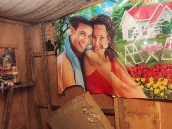
Tentoonstelling: One Day I'm gonna Make it
One day I'm Gonna make it. Dromen over hoe je leven er over een paar jaar uit ziet, dat kent iedereen wel; een mooi huis, een liefhebbende partner, een goed inkomen, een gezin, een goede baan. Of wellicht wonen in het buitenland, op avontuur door de wereld en je talenten ontwikkelen. Wie zal het zeggen? Wat heb je nodig om die dromen te verwezenlijken? Welke risico’s komen daar bij kijken? In hoeverre zijn die dromen te rijmen met de werkelijkheid?
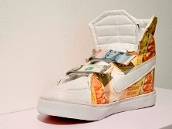
Making Way: Contemporary Art from South Africa and China
Explores the ways in which contemporary artists based in South Africa and China engage with new paths of movement, with economic and cultural shifts, and with the rise of new regimes, new leaders and new social and urban spaces. The exhibition includes works in diverse media by internationally acclaimed Chinese artists, Wu Junyong, Chen Qiulin, Maleonn and Qin Ga and local artists Lebogang Rasethaba, Gerald Machona, Michael MacGarry and James Webb.
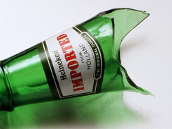
Kendell Geers 1988-2012
Kendell Geers, born in 1968 in South Africa, uses various media such as installation, drawing, video, performance, and photography. His life and work can be divided into two decade-long periods whose trajectories and developments are explored in this exhibition. The first political phase runs from 1988 to 2000, during which time the artist, a white South African, explored the moral and ethical contradictions of the apartheid system through his practice. Initiated by his move to Brussels in 2000, his later European period is now characterized by a more poetic aesthetic. Here, Geers transferred his incendiary practice into a postcolonial and increasingly global context, suggesting more universal themes like terrorism, spirituality, and mortality.
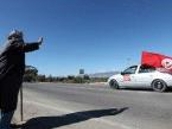
Film: Rouge Parole
In Tunesië, waar de Arabische Revolutie in 2010 losbarste, hebben tirannie en onderdrukking plaatsgemaakt voor democratie en vrijheid van meningsuiting. Voor het raam van een boekenwinkel kijken voorbijgangers hun ogen uit als ze een veelheid aan lang verneden boeken in de etalage zien prijken. Op straat voeren kleine groepjes mensen verhitte discussies. Journalisten mogen eindelijk écht hun beroep uitoefenen, maar zoeken nog naar de juiste woorden. Rouge Parole is een poëtische documentaire over de 'explosie van woorden' die voortvloeit uit de herwonnen vrijheid. Movies that Matter on Tour, verschillende bioscopen.

Amanda Strydom: Ek Loop Die Pad
Amanda Strydom is in haar vaderland Zuid-Afrika een superster, zo eentje met een onaantastbare status, een levende legende. Wat een stem heeft Strydom! Tijdloos, vol kracht, doorleefd. "Ik vind u écht geweldig, de liedjes zijn prachtig poëtisch", zegt Frits Spits. Stephan Sanders vergelijkt haar met Jacques Brel, Jacques Klöters vindt haar de top in het Afrikaans en Gerard van Maasakkers sprak: "Ik heb de hele voorstelling op het puntje van mijn stoel gezeten.
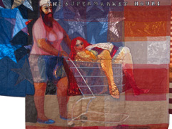
Hassan Musa - Installation, Assembled textiles
Musa is one of the most important contemporary artists of both Arabic and African heritage. Musa’s work approaches Western civilization as subject matter by referring to its iconography, thus questioning North/South relations and the dialogue between cultures. Always connected to the contemporary actuality, his works express at the same time his dual African and Oriental identity. This “identity” is also reflected by Musa’s role as an acclaimed calligrapher.
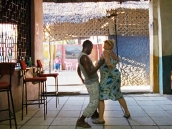
Paradies: Liebe (film)
Teresa is een alleenstaande, middelbare Oostenrijkse huisvrouw die op strandvakantie naar Kenia gaat. Of ze wist wat ze daar zou aantreffen laat de film in het midden, maar voor ze het weet is Teresa omringd door 'beach boys'. Die haar spulletjes proberen te verkopen, excursies, en bovenal zichzelf. De kracht van Paradies: Liebe is dat Seidl geen daders of slachtoffers aanwijst. Teresa gebruikt de 'beach boys' en die gebruiken op hun beurt Teresa. In Seidls universum is iedereen slachtoffer én dader. Eerste in de Paradies-trilogie. Andere delen: Glaube en Hoffnung.
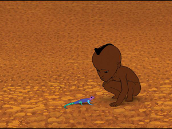
Film: Kirikou en de mannen en de vrouwen
In een dorpje in Afrika vertelt een oude grootvader een reeks nieuwe verhalen over de held Kirikou. Hij heeft nog veel mooie herinneringen uit zijn kindertijd, zoals de momenten waarop Kirikou de mannen en de vrouwen van zijn dorp hielp. Zo vertelt de oude grootvader ons hoe Kirikou door zijn moed en intelligentie de forse vrouw te hulp schoot wiens dak was vernietigd door de boze heks Karaba. En over hoe Kirikou de mopperende dorpsoudste terugvond die verdwaald was op de savanne en over de Afrikaanse vertelster die bedreigd werd door de tovenares.
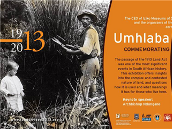
Umhlaba 1913-2013 Commemorating the 1913 Land Act
The Land Act of 1913, and associated legislation that was to follow during the apartheid period, had a devastating effect on the country and on the lives of millions of black South Africans. This photographic exhibition gives visitors the opportunity to follow a century-long journey into the history of the land, into land struggles, forced labour and child labour, removals, and last ditch stands. Historical photographic material gleaned from archives is exhibited alongside modern and contemporary work in new ways to explore the romance with and realities of the land, both in the past and the present.

Genesis - portriats by Ryan Hewett
In this show the artist continues his exploration both of portraiture and his passion for oil as a painterly medium. Contrary to the tradition of verisimilitude, for Hewett the portrait is not about capturing an external likeness of a subject; but rather as a portal to an inner journey of self-exploration. Hewett does not use sitters or models in an effort to produce a realistic depiction. Although photographs constitute his starting point , he relies principally on the free-flowing processes of memory and creative imagination. His portraits encapsulate the truism: that the subject matter of all art is, ultimately, the self.

Exhibition: Belinda Blignaut - blown
Through a varied series of works and actions created and documented over several years, Belinda Blignaut has been processing issues around social constraint and transformation, with the body at the centre of all; an emotional response to a political world. Adapting available materials and processing immediate surroundings, she hopes to translate the ways we cope. Her work is often body canvas, a quiet visceral investigation into violence through action and documentation. Surfacing in blown is a desire to resist the effects of institutionalized culture and the constructs of sophistication we have become - how good we are at concealing messiness, the natural body, and intuition.
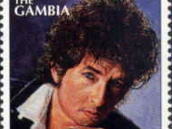
ASC Exhibition: Music on African stamps: Western music
Music as an expression of national identity is a common theme on stamps. That was also the case with the stamps of the previous Music-on-African-stamps exhibition. However, the stamps of the present exhibition show a very different picture, which has nothing to do with national identity: European composers and western “heroes of popular music”. Stamps showing European composers like Ludwig van Beethoven, Igor Strawinsky, Johann Sebastiaan Bach, Georg Friedrich Händel, Wolfgang Amadeus Mozart, black music heroes like Louis Armstrong, Billy Holiday, Muddy Waters, Mahalia Jackson, Lionel Hampton and Jimmy Hendrix and white music heroes like Elvis Presley, The Beatles, Jerry Garcia, Janis Joplin and Bob Dylan.
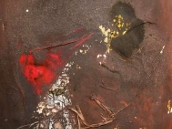
Thabiso Phokompe - Tracing Home (mixed media)
Thabiso Phokompe (born in South Africa) is an artist currently creating work that reflects his life as a contemporary African artist living in New York City. Drawing on continual themes of bringing polar opposites together, his recent works comment on the experience of living in the African Diaspora. Working between paintings and sculptures, Phokompe incorporates natural fibers, wood and soil as materials that metaphorically connect him to his ancestral home in Africa. These materials are combined with industrial substances such as: oxides, color pigment or cement, plastic sacks, nails, bottle caps, staples and acrylic paints.

Mary Wafer - Mine (paintings)
The series of paintings on this exhibition derive from a reflection on the events at Marikana of 16 August 2012. A strike at a Lonmin owned platinum mine in the Marikana area close to Rustenburg lead to a series of violent confrontations between police, mine security officials, trade union leaders and miners in which around 47 miners were killed and an unknown number injured. The paintings are partially abstracted landscapes derived from media images and my own visits to the site where the massacre happened.These works are an attempt, within the possibilities of painting, to find a way of responding to, and reflecting on, these events and the place in which they occurred.

Jodi Bieber - Between Darkness and Light
Award-winning photographer Jodi Bieber explores the twilight that she experienced in the decade following the advent of democracy in South Africa. The show is a selection of work from 1993 to 2004, primarily revealing Bieber’s more rarely shown independent series, as well as some of her earlier work as a press photographer.
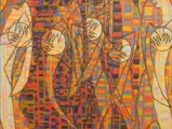
Beyond Boundaries - exhibition
9 visting Nigerian artists exhibit paintings and sculptures. Tayo Olayode, Aimufia Osagie, Adekusibe Odunfaa, Bimbo Adenugba, Okpu Norbert, Olumide Onadipe, Damola Adepoju, Umeh Bede and Kehinde Oso, all members of the Society of Nigerian Artists (SNA), are taking the leap forward into new territories with recent works of paintings and sculpture to be shown at the Nubuke Foundation. This bold initiative is one welcomed and supported by Nubuke Foundation since it opens the path for new dialogues to take place in the contemporary art scene in Ghana.
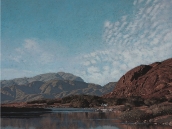
My Country - John Meyer (10 iconic South African landscapes)
For many years the diverse and varied landscapes of South Africa have been an inspiration for John Meyer. Since his first solo exhibition with Everard Read in 1972, Meyer has dramatically captured the essence of the terrain of his birth country, from the arid Karoo to the spectacular Drakensberg; from the abandoned wilderness of the coast or the bushveld, to the ordered grandeur of the winelands. This collection of paintings is a commissioned series which has taken two years to complete. Meyer has painted ten of the most arresting vistas that embody, for him, the essence of this country.
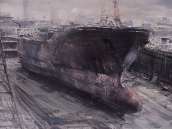
Alessandro Papetti - paintings
In this new series of large scale paintings, depicting Industrial Landscapes, Interiors and Human Figures, Alessandro Papetti revisits subjects that are dear to him and through which he reveals, with his unique expressive force, his vision of the world. Facing Papetti's works the viewer is confronted poignant visions of abandoned industrial scenes where the shadows of long past activities are still faintly perceived among the rusting machinery. The immense dockyards where great ships look like naked, gigantic Leviathans, with steel bones and hard skin. And when Papetti's eye lingers on Human Figures and austere Interiors,one hears lost voices, witnesses recreated gestures - the transient essence of life.

Looking Back - paintings by Robert Hodgins
At the end of Robert Hodgins’ long life, he found being ill “just too tedious!” and was frustrated at the fact that “ I cannot paint!” He was involved in The Great Human Drama, right to his last day. Possessed of a mischievous and curious eye with which he critically evaluated the doings of humankind; a lively wit, the sensitivity to include himself in his impressions of our species, and a healthy cynicism, Hodgins was above all the keenest observer of life one could meet. Painting, drawing and printing constantly taught him more about life and the process of producing images.
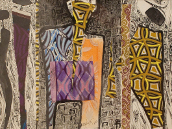
Facing Form - expositie
Vorm als verbinding in het werk van de deelnemende kunstenaars. Gezichten/gedaantes in vorm verbeeld, tussen figuratie en abstractie. Hans van der Ham (NL), sculpturen/schilderijen, Victor Ekpuk (Nigeria), schilderijen/tekeningen, Obinna Makata (Nigeria), werken op papier, Uche Uzorka (Nigeria), tekeningen.
